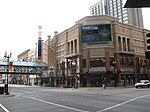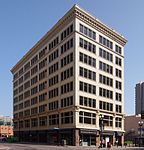Target Center

Target Center is a multi-purpose arena located in Minneapolis, Minnesota, United States. Opening in 1990, it hosts major family shows, concerts, sporting events, graduations and private events. Target Corporation, founded and headquartered in Minneapolis since 1902, is the original and current naming rights partner of the arena.The arena has been the home to the Minnesota Timberwolves of the National Basketball Association (NBA) since its opening and is currently also the home of the Minnesota Lynx of the Women's National Basketball Association (WNBA). The facility has also hosted the LFL's Minnesota Valkyrie, the RHI's Minnesota Arctic Blast and the Arena Football League's Minnesota Fighting Pike in the past. The arena is the second-oldest in the NBA after Madison Square Garden.
Excerpt from the Wikipedia article Target Center (License: CC BY-SA 3.0, Authors, Images).Target Center
2nd Avenue North, Minneapolis
Geographical coordinates (GPS) Address External links Nearby Places Show on map
Geographical coordinates (GPS)
| Latitude | Longitude |
|---|---|
| N 44.979444444444 ° | E -93.276111111111 ° |
Address
Target Center
2nd Avenue North
55401 Minneapolis
Minnesota, United States
Open on Google Maps








